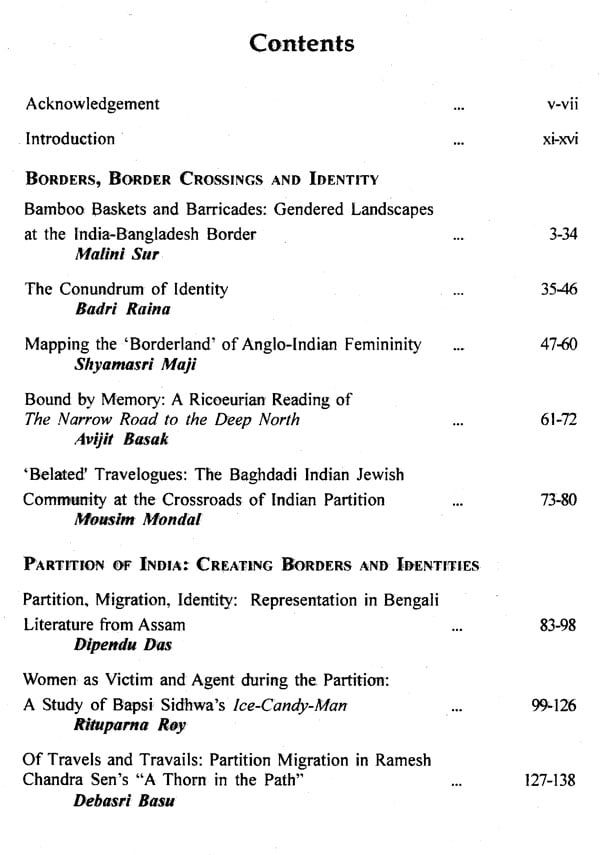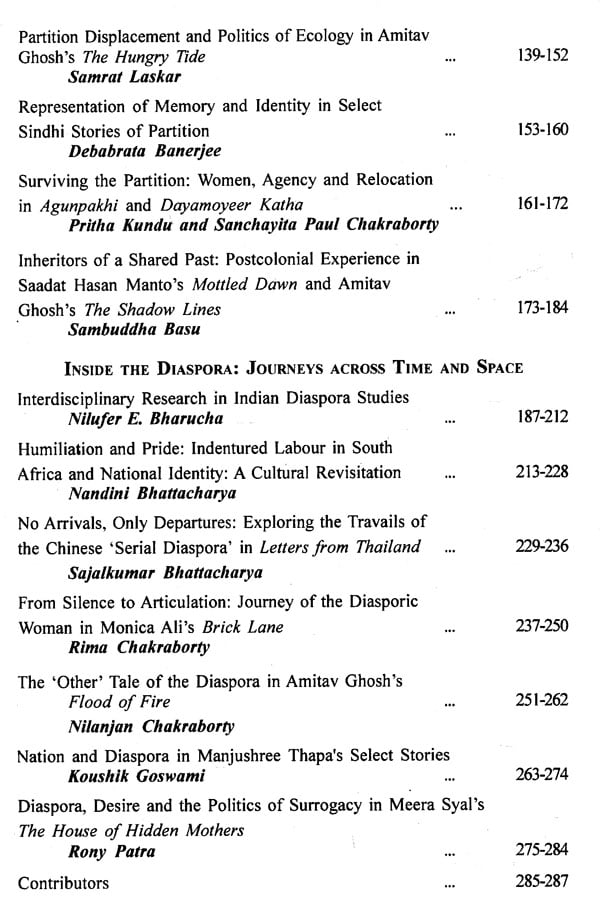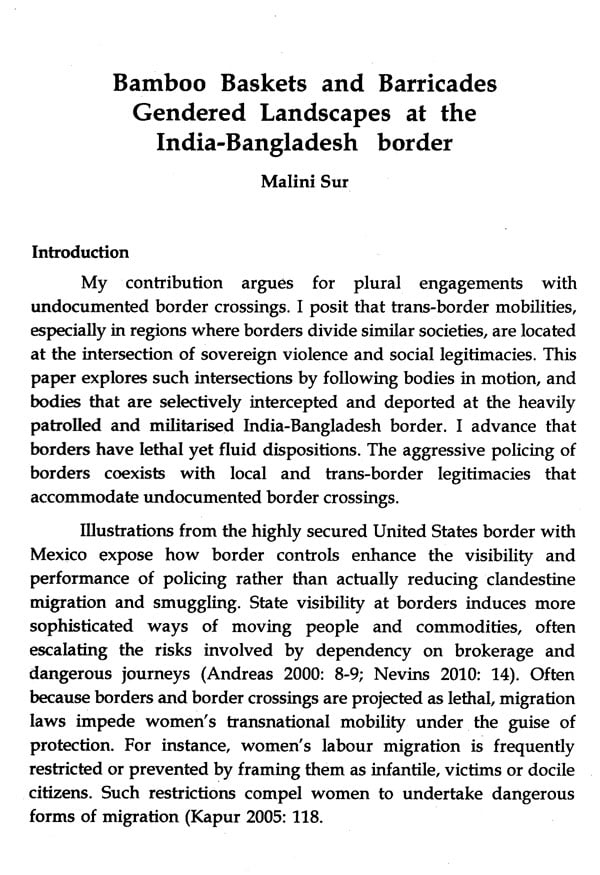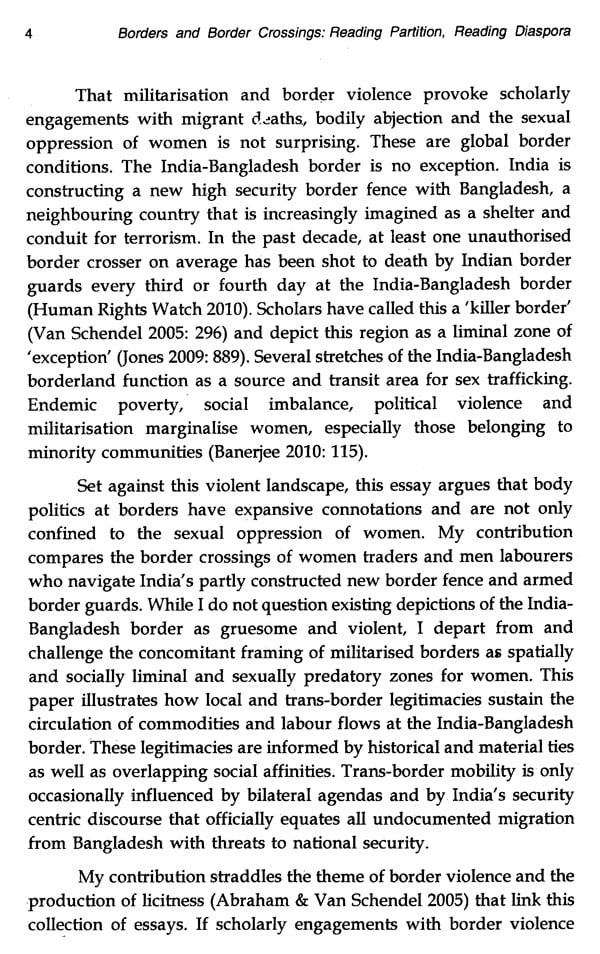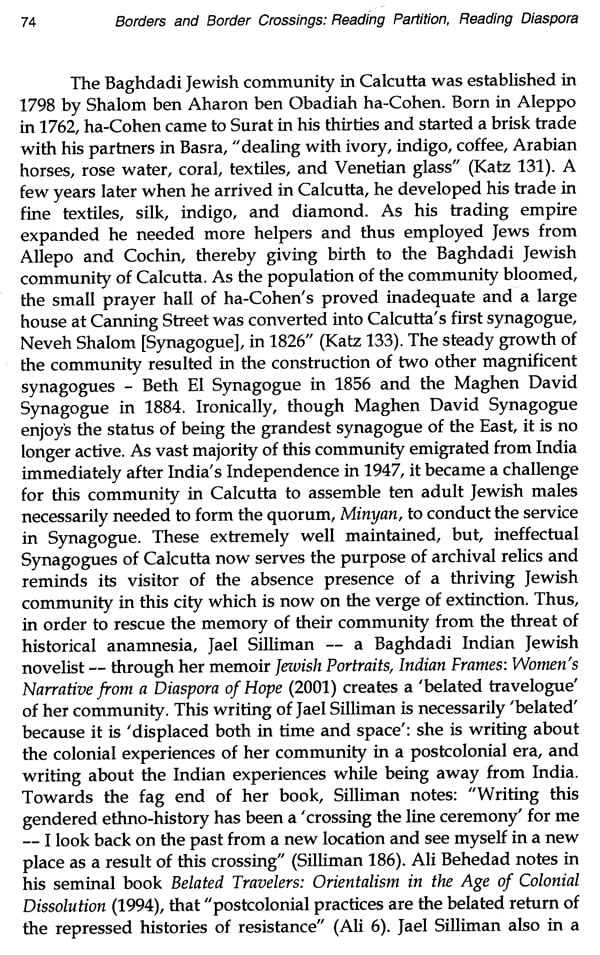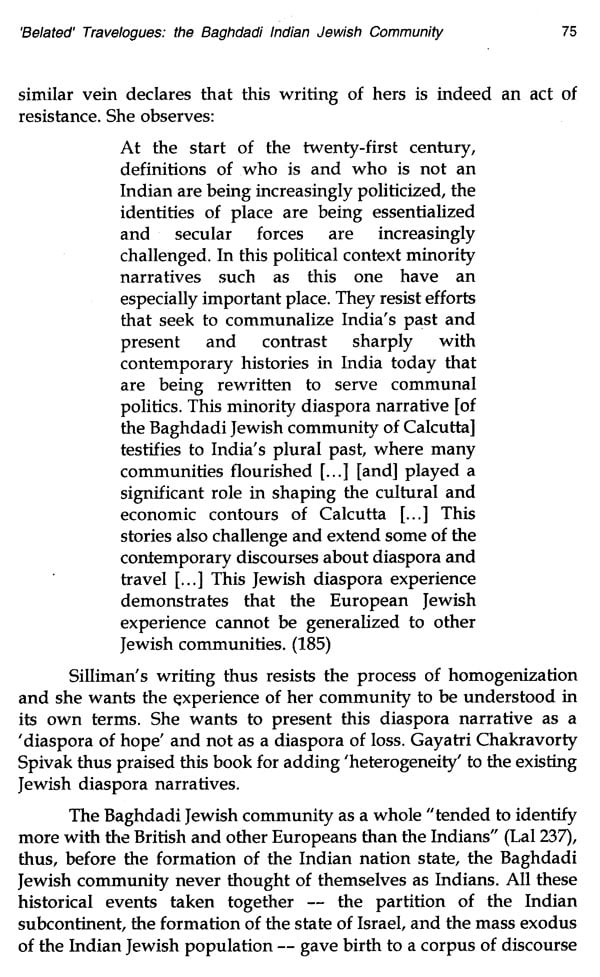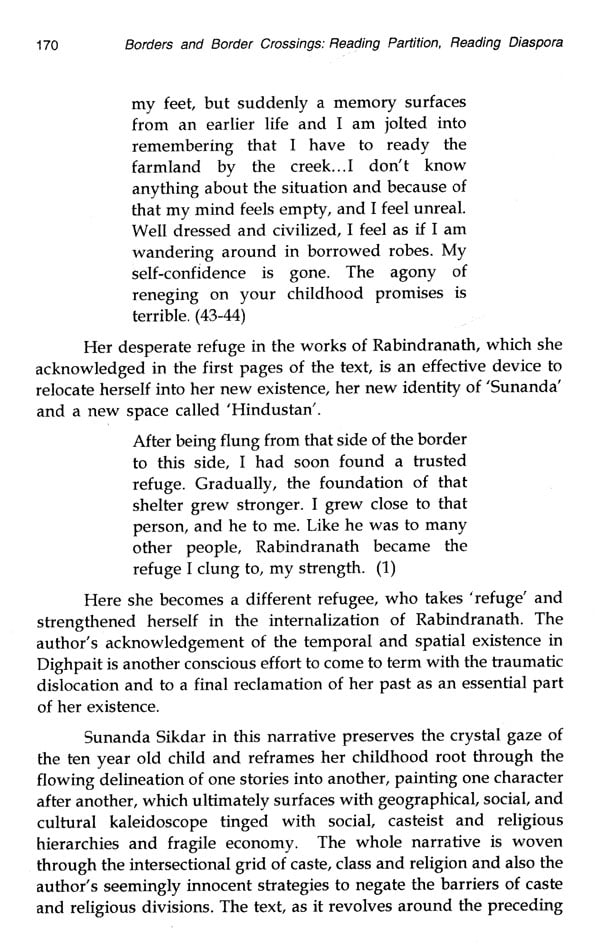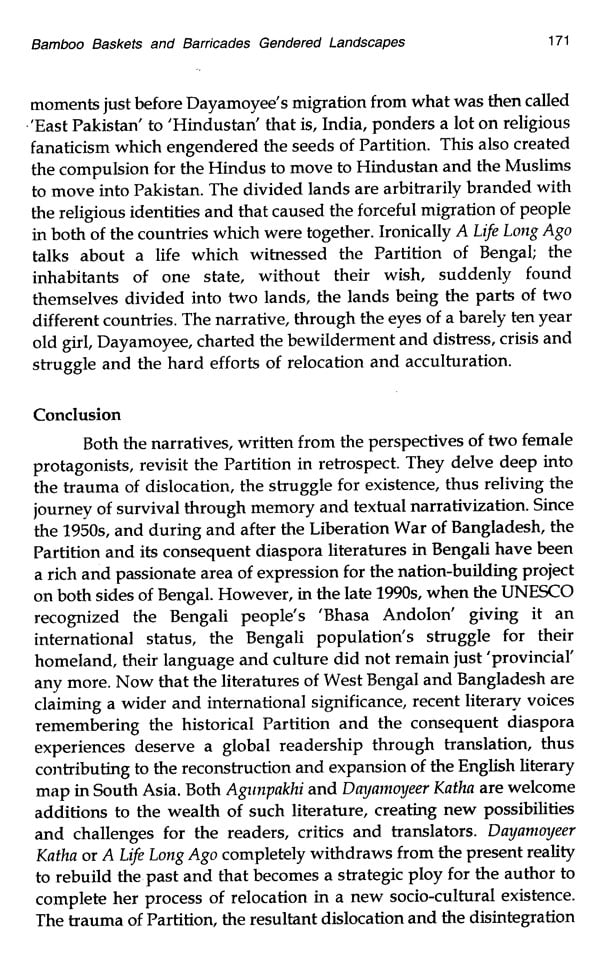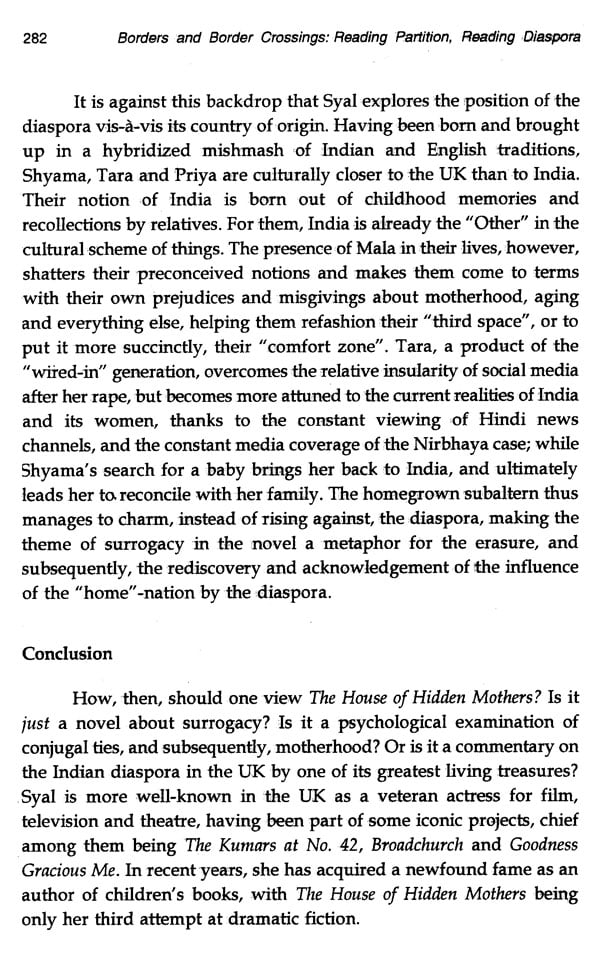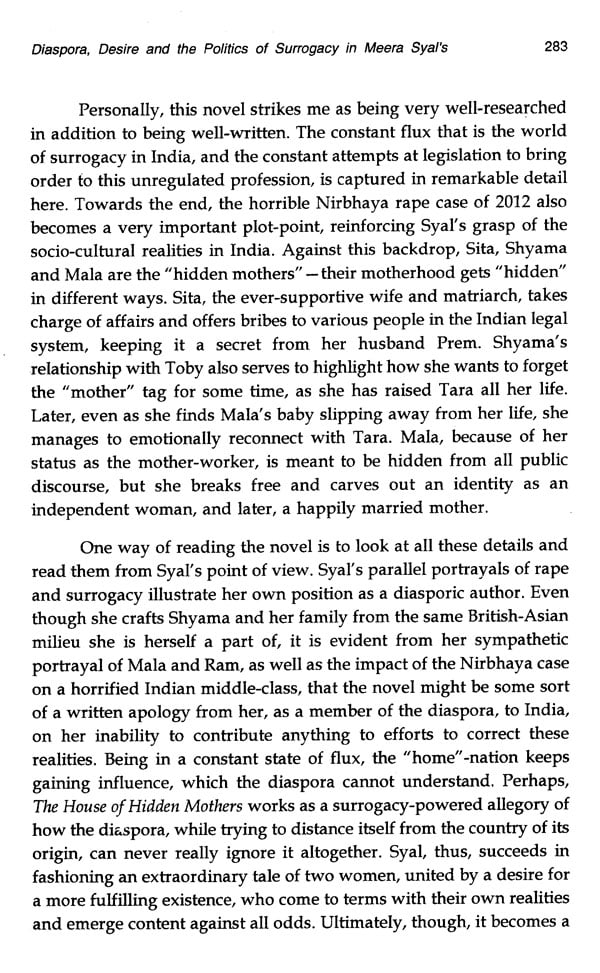
Borders and Border Crossings : Reading Paritition, Reading Diaspora
Book Specification
| Item Code: | NAZ623 |
| Author: | Deb Narayan Bandyopadhyay, Himadri Lahri and Nandini Bhattacharya |
| Publisher: | The University of Burdwan |
| Language: | English |
| Edition: | 2016 |
| ISBN: | 8187259930 |
| Pages: | 288 |
| Cover: | HARDCOVER |
| Other Details | 9.00 X 6.00 inch |
| Weight | 500 gm |
Book Description
Border and Border Crossings; Reading Partition, Reading Diaspora engages with the impossibility inevitability of borders, and the inevitability/impossibility of their crossings. The book maps the literary and cultural narrativization of complex experiences that human movements across borders/boundaries produce. This is an equally fascinating study of how literary, cultural texts and textual structures inform such experiences. The narrativization of experience(s) of homelessness, fragmentation, loss of identity and the imaginative recreation of home/identity within an unheimlich space, has often shaped politico-socially viable identity positions, and motivated politico- social struggles to achieve the same. In conceptual terms, borders, boundaries operate as the organizing principle and that brings together these two areas (Partition of India and Diaspora) of examination. For another, the colonial intervention in the Indian subcontinent inevitably necessitates a study of South Asian diasporas and Partition movements, together. The violence of the colonial intervention acerbated the problematics of borders, politics of identity, and made the study of these area in their intersectional overlappings, inevitable. This interdisciplinary volume is marked by explorations of diverse border crossing experiences, and myriad generic forms that make such experiences palpable.
Professor Deb Narayan Bandyopadhyay is the Honourable Vice-Chancellor of Bankura University, Bankura, West Bengal, India. He is an Honorary Research Associate of Monash University, Australia and also a Visiting Fellow of University of New South Wales, Australia. Professor Bandyopadhyay is Co-ordinator of the UGC-DRS SAP 1 project of the Department of English & Culture Studies, University of Burdwan. He has to his credit many international and national publications.
Professor Himadri Lahiri has completed his Post-graduation from the University of Burdwan, M.Phil. from Jadavpur University and Ph.D. from the University of Burdwan. Besides, he also did his PGCTE & PGDTE from the Central Institute of English and Foreign Languages, Hyderabad (now EFLU). He was awarded Olive I. Reddick Prize by Indo-American Center for International Studies in 2001 and is a fellow of Salzburg Seminar American Studies Alumini Association Salzburg Seminar, Austria, 2006. His areas of interest include Modern British Poetry, Diaspora Studies and Indian English Literature.
Professor Nandini Bhattacharya, Head, Department of English & Culture Studies, has graduated from Presidency College, Kolkata, and completed her M.Phil. and Ph.D. from the University of Jadavpur. She has been Associate Professor in the Centre for Comparative Literature, The University of Hyderabad, and served an invited deputation as Professor, Head, Department of English & Comparative Literature, and Dean, School of Languages, Central University of Jammu, J&K. Her areas of specialization are Critical Theory, Translation Studies, Genocide and Peace Studies, Gandhian thought, 19th Century Bengal Studies, Transitional Justice Studies, Ethics Law and Literature Studies.
The Burdwan University Press published book (December, 2016) BORDERS AND BORDER CROSSINGS: READING PARTITION, READING DIASPORA (edited by Professors. D.N. Bandyopadhyay, Himadri Lahiri and Nandini Bhattacharya) is an interdisciplinary collection of essays produced and edited by the Faculty of The Department of English and Culture Studies. It boasts of an array of essays by reputed national and international scholars.
It is a volume that commemorates and mourns the imminent 70% year of Partition of the Indian subcontinent. It also speaks of diasporic living as a result of such uprooting. The volume is in many ways a timely intervention because the essays speak of a borderless world and the role of literature in promoting the same. The essays in the book condemn rigid identity formations and foregrounds Gurudev Rabindranth’s view of viswa manav and viswa manavata.
My role as the new Vice Chancellor of The University of Burdwan has been that of a facilitator of such research oriented work. I hope that many such research oriented publications happen during my tenure and I encourage The University of Burdwan to become a centre of cutting-edge scholarship.
The functioning of the Burdwan University Press with its printing machines was in a sense initiated by the Maharaja of Burdwan as he had donated the machines and equipments such as treadle press to the University. These machines, though now obsolete, are still part of the Press and add to its heritage value.
Needless to mention that the Maharaja had promoted and funded the publication of important Indian texts, especially epics such as the Mahabharata, in Bengali. The Maharaja Mahatab Chandra Bahadur also encouraged the use of woodcut graphics in this Bengali Mahabharata to make this Bardhaman edition of Mahabharata an all-India, and all-time favourite.
Subsequently, the Burdwan University Press has published many globally renowned and frequently cited scholarly books of repute, as well as text books, for the aid of its affiliated colleges. The Burdwan University Press has also become a source of a certain amount of revenue generation for the University because its knowledge-texts are widely respected, and popular buying material for scholars and students.
It is my great pleasure to announce the revival and re-energizing of the Burdwan Unviersity Press with new scholarly volumes, such as this one. It will bring glory to the Department of English and the University of Burdwan and take forward our beloved CM’s hope of achieving Excellence (one of her target E,s among three other Es) and making of a Bishwa Bangla where the world’s attention is turned towards our state.
Borders and Border Crossings: Reading Partition, Reading Diaspora engages with the impossibility/ inevitability of borders, and the inevitability/ impossibility of their crossings. The book maps the literary and cultural narrativization of complex experiences that human movements across borders/ boundaries produce. This is an equally fascinating study of how literary, cultural texts and textual structures inform such experiences. Diasporic literature is that one genre which (paradoxically enough) produces the idea of diasporic existence and contours its politico-social dimensions. The narrativization of experience(s) of homelessness, fragmentation, loss of identity and the imaginative recreation of home/identity within an unheimlich space, has often shaped politico-socially viable identity positions, and motivated politico-social struggles to achieve the same. The recognition of distinct but complex diasporic identities between the either/or of nation- states is often a literary and cultural phenomenon. Because thought comes first.
The book hopes to create new and accessible knowledge systems that explicate, illumine and render experiences of Indian Partition and South Asian diasporic existence meaningful in epistemic terms. While it foregrounds patterns of violence (inevitable in any border crossing event) the book is distinct in its mapping of a minefield of affects—hatred, mistrust, resentments, repulsion, informed as they are by ideological beliefs, and chosen identity positions, and colour as they do such border crossing movements. What is remarkable as well is a study of unlikely connections that are forged.—loves and desires that irradiate border crossing—times.
Memory, its myriad dimensions, is inevitably one of the central concerns of the book. Borders are also borders of time; boundaries of the ‘pastness of pasts’ that may be never re-covered; mourning for lost homes that become, and do not become today’s Electras. Hopes of future re unions and re-covering of imagined homelands, complicate cultural narratives and the "presentness of presents’ is marred by the palpability of hope, belief in re-turn to the imagined homelands of the future. Such_ intersectional awareness enriches the debates in this book. Joginger Paul’s novella entitled Sleepwalkers (originally Khwabrau in Urdu/, narrativizes an old Mohajir character - Deewane Maulvi Sahab. He now lives in Pakistan (and having left Lucknow a long time ago during Partition), but still firmly believes that he is in Lucknow. This is a case in point.
The mind that registers the shock of uprooting responds to ‘reality’ in unforeseen ways, and creates ‘viable, realities’ to dwell in. The traumatic experience of the Indians being forced out of Idi Amin’s Uganda (as represented in Meera Nair’s Mississippi Masala) or the terrifying experience of communal riots which drove people out of their homes and hearths during the Partition of India necessitated creation of new realities of existence in spacio-temporal terms. This is what this volume attempts to chart.
Why did we, the editors, yoke together fields as vast, complex and disparate as the Partition of the [Indian subcontinent studies and Diaspora Studies, and what did we seek to achieve in epistemic terms? For one thing. in conceptual terms, borders, boundaries operate as the organizing principle and that brings together these two areas of examination. For another, the colonial intervention in the Indian subcontinent inevitably necessitates a study of South Asian diasporas and Partition movements, together. The violence of the colonial intervention acerbated the problematics of borders, politics of identity, and made the study of these area in their intersectional overlappings, inevitable.
The other interesting focal point of the volume on borders is the study of ambivalence. There are thousands that cross Indo-Bangladesh border, more often than not, in an illicit manner each day, to earn a daily living. They work as daily labourers, maid-servants or rickshaw pullers, and return ‘home’ at the end of the day before the border is ‘officially’ sealed. Their daily routine is marked by cross border movements and the ambivalence inherent to their existence complicates questions of affiliation to either/or nation state. Citizenship of either states in such porous border lands can be purchased (un)officially through organized racket of middlemen, police. Border Security Forces, and purchased also in terms of days or hours. All these complicate questions related to affiliations. rights, duties of the nation state. The status of the residents of what is known as ‘Chhitmahal’ regarding which the governments of India and Bangladesh made agreements recently exemplifies such existential dilemma. Cross border terrorism in the states such as Jammu and Kashmir also complicates the question of national affiliation. Ambivalence is woven into the lives of the border dwellers.
Migrants, women. especially those travelling to new countries after marriage, or for jobs, victims of ethnic or racial cleansing, IT professionals, militants, all occupy and complicate the experience of dwelling on these border zones.
The book has roughly three anchor points from where it explores and debates issues: 1) the Partition of India, 2) movements of population across national borders, and 3) human existence in conditions of diaspora.
While the anchor points of the volume appear to overlap because they all explore movements, they are distinct because every movement is imbued with inherent differences of signification and impact. The primacy given to the Partition of India as an explorative vantage point is because it has possibly the greatest visible impact on lives of some of the contributors of the given volume, and because contemporary Indians are in in every sense of the term — ‘post —partition.’ The overt violence that marked Partition movements offers comparative frames of reference in so far as study of diaspora movements are concerned. Diasporic movements, however, even the older ones, were not necessarily the result(s) of overt coercion, and the ‘pull’ of a better life free from from caste, community, gender restrictions in late 19%, and early 20" century actually acted as incentive for indentured labour from the Indian subcontinent. But the substratum of violence, the ‘push’ of famines, extreme poverty of the subalterns of a colonized state that produced such ‘contracts’ call out for fresh explorative structures. All these historical ‘events’ resulted in displacements, processes of resistance, acculturation, assimilation, nativist identity formation movements, but their patterns continue to operate under ‘signs of difference.’ The task of the editors is to identify and explicate these differences.
Passage of time and generational shifts play a pivotal role in these processes and in the crystallizing of conceptual patterns that try to make sense of movements in terms of knowledge systems. Looking at the time of displacement from the vantage point of another time and another generation lends a different perspective to the very event of displacement. These ‘belated’ returns to the events create, to borrow Ali Behdad’s word, ‘anamnesic’ consciousness. As a result, aspects, issues and geo-cultural locations, previously ignored, are discovered, debated, conceptually realized and disseminated as public knowledge. The proposed book is designed to foreground several such issues that call out for fresh analysis from hitherto unexplored perspectives.
Finally, the book also ‘looks back’ to issues of human movement and border crossings/dwellings from the vantage point of socially accepted time segments (50 years, 100 years and so forth). Such segmentation of time and re-memoration at such moments are rendered meaningful through social consensus and assume iterative nuances in epistemic terms. It is an examination and creation of knowledge system after ‘150 years’ of abolition of indentured labour, or the ‘70th year’ of Partition of India, and so even though these time segments are meaningless by themselves, the acts of re- memoration during or at/during the time segment, are socially meaningful and epistemically fraught acts. Knowledge systems are also produced and rendered meaningful through segmentation of time and through commemorative events.
Though this book is based on some articles presented in the last international conference that was funded by the UGC DRS-SAP programme of the Department of English and Culture Studies, The University of Burdwan, in March, 2016, this is much more than a conference proceedings. Several invited articles from scholars, located both in India and abroad, have been includes, to give the volume its necessary critical balance and to irradiate the concept of border crossings/dwellings from every possible vantage point.
The book is ‘divided’ (and we use this word with considerable humour as all these divisions are also porous and overlapping) into three sections namely:
- Borders, Border Crossings and Identity;
- Partition of India: Creating Borders and Identities;
- Inside the Diaspora: Journeys across Time and Space.
The first section contains five essays that are primarily theoretical in nature. and aimed at identifying some particular geo-cultural and/or discursive issue. The articles argue that borders are indeed porous, despite every attempt of nation states to seal and sanitize and render them distinct. People and professions in particular are meant to straddle borders and it is in their diurnal breaching of barbed wires that ‘national’ borders are rendered immanent. Borders, like barbed wires, are not always visible. Special zones such as Armed Forces Special Powers Act enforced areas in Jammu and Kashmir. or Emergency laws imposed in Mao ideogue-fighter inhabited heartlands of India, are invisible borders within the nation state. Internal border making is a ceaseless and convoluted process. The relentless statist process of biopolitically identifying the ‘not-pertinent,’ ghettoizing, incarcerating or destroying them to optimize the ‘pertinence’ of its pertinent members is what renders ‘border debates’ so relevant and fascinating.
The second section dwells on the issues of the Indian Partition and contains seven articles. Some of these explore more well-known texts, while the others dwell on less known areas such as the effect of Partition on Sindhi communities. This section throws some light on new dimensions of the refugee/Partition problem in states like Assam in the Northeast of India and brings to fore such representations in new writings in Bangla.
The third section is specifically devoted to exploration of old and new diaspora and contains seven articles. The articles on indentured diaspora in South Africa, Indian Ocean and the Caribbean islands and the stories of jahajibhais throw new light on the border crossings that took place in the nineteenth century or early twentieth century. Literary representations of the new diaspora from South Asian, Southeast Asian countries and Australia I also form the subject of certain essays in this section.
This interdisciplinary volume is marked by explorations of diverse border crossing experiences, and myriad generic forms that make such experiences palpable. One may, after Hannah Arendt, state that, traumatic experiences become bearable, and more meaningful when they are narrativized. We narrativize borders.
Book's Contents and Sample Pages
